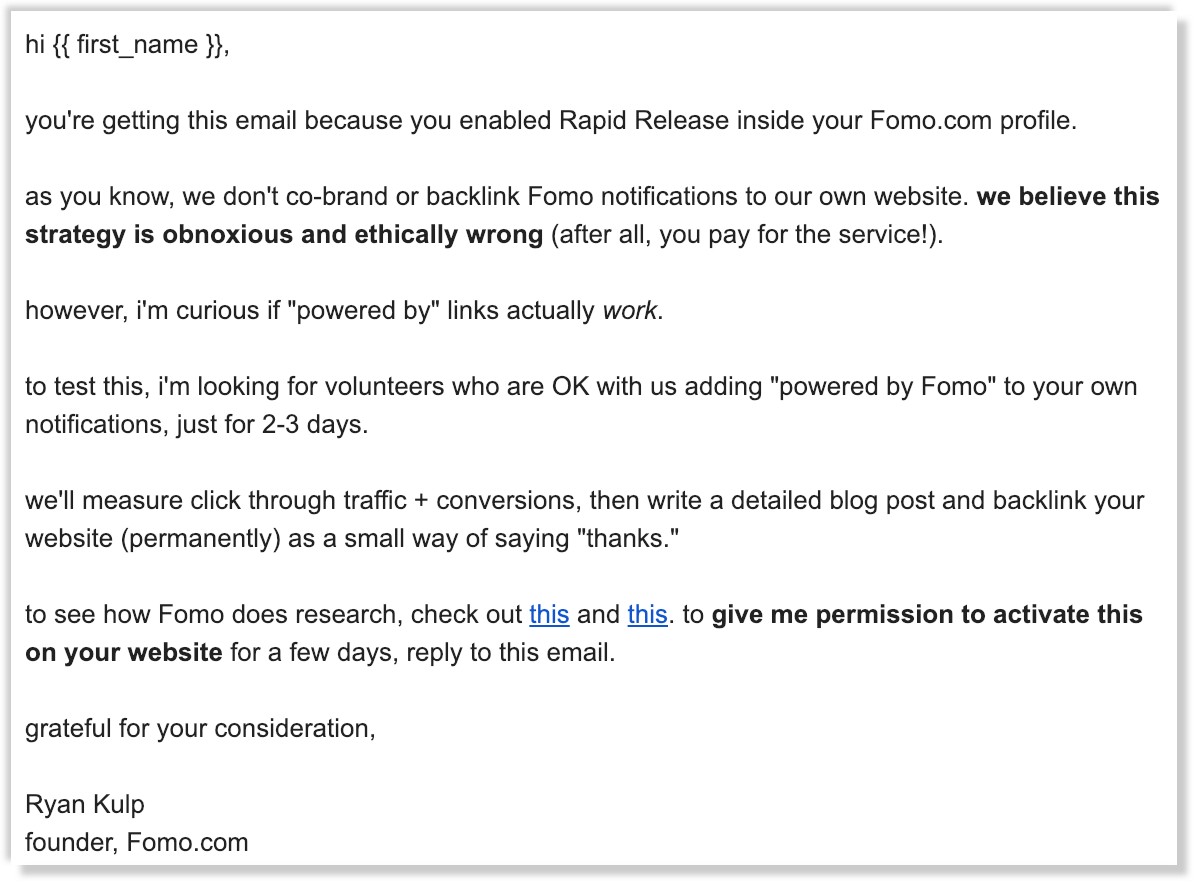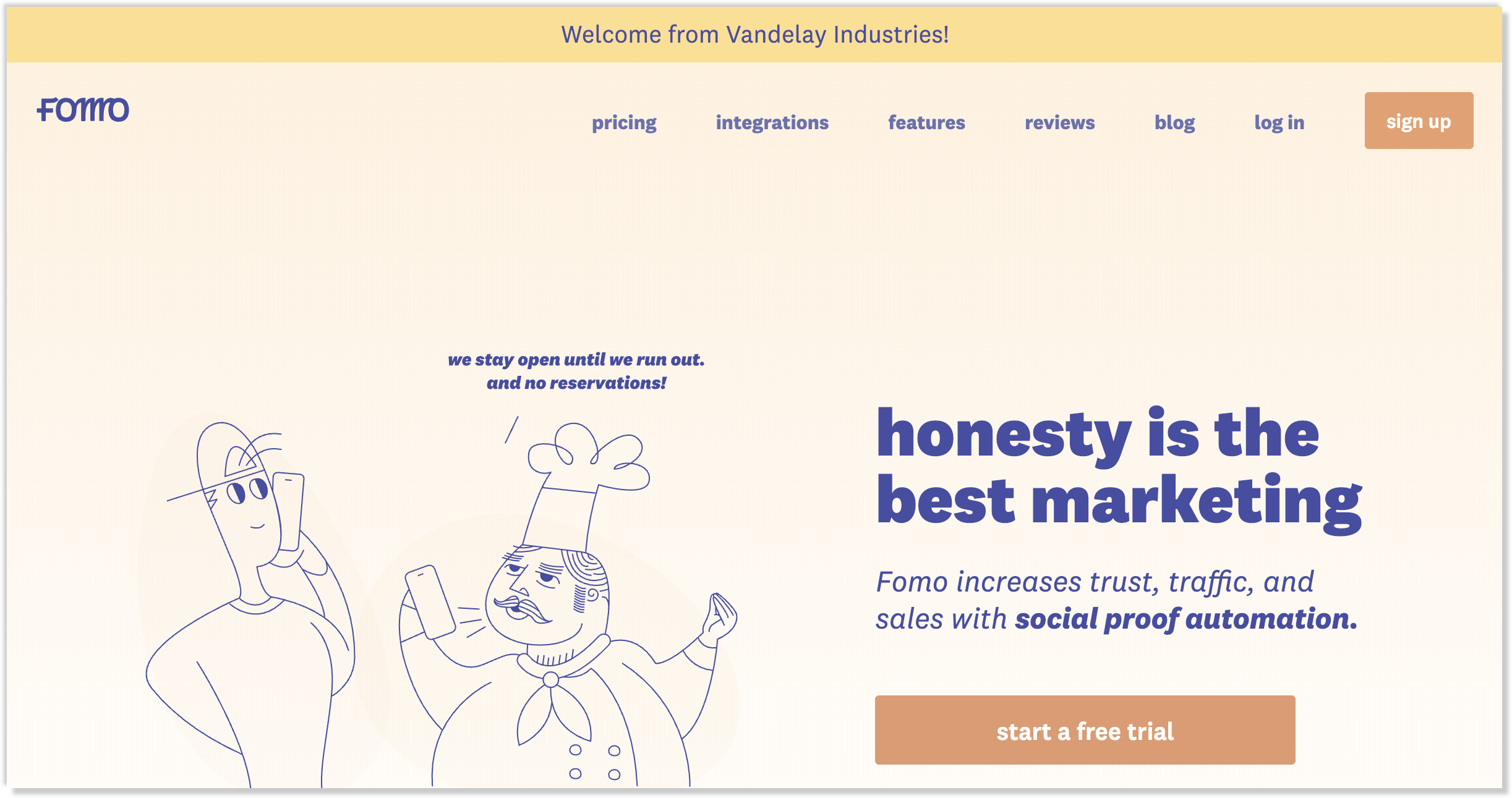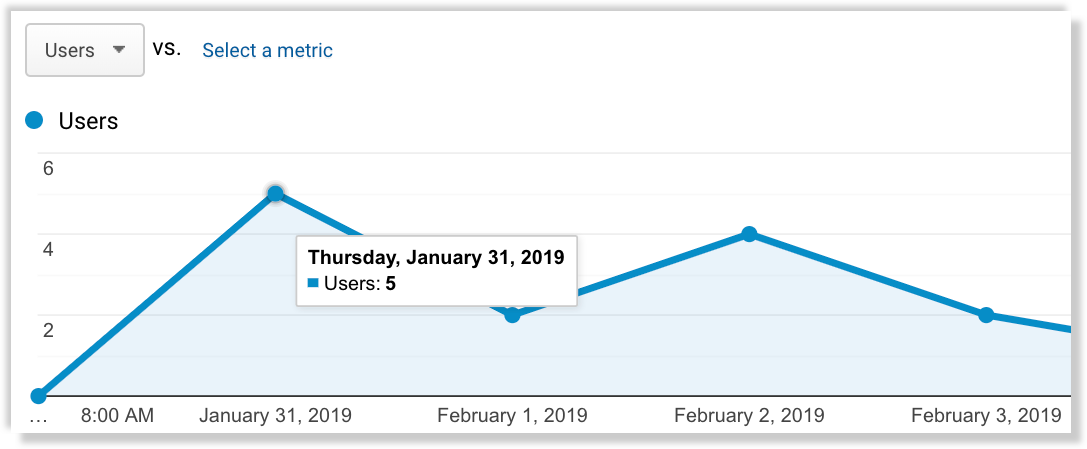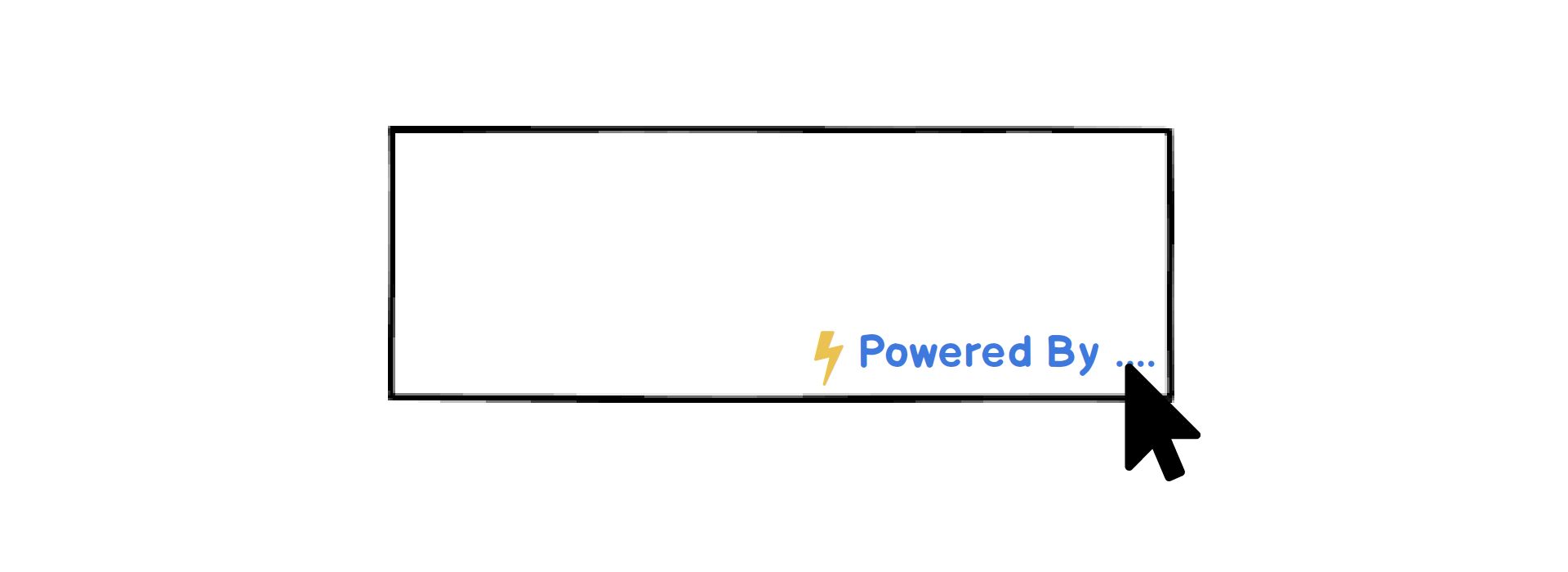Do "Powered By" backlinks actually work?
while we've never considered Fomo a "widget," its client-side implementation as an embeddable, asynchronous JavaScript snippet technically classifies it as such.
so when we launched a free plan in 2016 (since discontinued) we did what all widgets do – backlinked our own homepage inside the product:

we required this on free plans, made it optional on paid plans. i figured this is an OK trade-off, and still do, for free software.
fast forward a few years, it's become the New Normal™ for even expensive apps to add promotional "powered by" links to every plan. (i'm looking at you, Intercom.)
realizing this, we removed the requirement and disabled "powered by" on 807 customer accounts immediately.
but what if it works?
curious, this week we recruited volunteers to find out:

offering a cash incentive would have been messy given traffic varies per customer. paying per click would encourage bad actors, and paying per day would be unfair to higher trafficked websites.
so we kept it simple: a public thank-you, which in 2019 means "backlink."
it's also kind of poetic... backlink for backlink... except we only needed 72 non-followed hours, and theirs will live forever. :D
experiment sample size
after emailing 136 candidates, 14 of them agreed to volunteer.
i also found 20 websites that already opted into Fomo's "powered by" option. perhaps they perceive the link as validation of their data, which is fine by us!
test tube: 34 websites.
methodology
i hooked up all 34 websites with a "Powered by Fomo" backlink, which (when clicked) sent their visitors to fomo.com/superpowers.
we actually added a little more spice to the links, so clicking from "Vandelay Industries" (for example) looked like this:

the slight personalization in the hero bar is designed to impress upon visitors that clicking our "powered by" link is encouraged by the source website.
my hope was to discourage immediate page bounces and foster more engagement, thus conversions.
results
we enabled the links on 34 websites for 75 hours.
it was supposed to be exactly 72 hours, but 10 minutes before "showtime" i started writing another blog post and didn't look at the clock for 3 hours. oops.
when i did turn off the backlinks, i purged every volunteer's website cache and waited a couple more days for Google Analytics data to finish aggregating.

total traffic: 12 clicks, 22 pageviews.
for context, total Fomo notification impressions across all 34 websites during this 75 hour experimentation window was 132,809. total clicks, around 306.
this means visitors on a Fomo customer's website were 25.5x more likely to click the notification's intended destination link -- e.g. to a product or signup page -- than our "powered by" promotional link.
ROI: zero Fomo signups.
what this means
Fomo gets more "impressions" than the average tool, including most live chat products. as of January 2019, over 54 million people see Fomo notifications every month.
if we scaled this experiment to our entire base – 11,000 active websites instead of 34 -- simple math says we would have observed around 3,600 clicks, or 1,200 per day.
(we'd probably get even more, since none of the biggest websites in my 135-person email request agreed to participate).
i have to think 1,200 clicks /day would yield > 0 signups, but how many exactly?
sketch projection
suppose we enjoyed 1% click-through conversion.
this is lower than our global conversion rate, but most of our customers sell to consumers, making Fomo irrelevant to the majority of click-through visitors.
at 1,200 clicks per day, that's 12 email signups per day. but only 1/3 email signups convert to free trials (requires a credit card), and about half of those folks stick around as paying customers.
1,200 clicks → 12 signups → 4 free trials → 2 new paying customers per day.
if every customer joined our least expensive, $39 /month plan, we could achieve as much as $2,340 new MRR per month ($39 /subscription * 2 people * 30 days).
this is great, but does not consider the counterfactual.
the opportunity cost of "Powered By" backlinks
Fomo welcomes 600-1,000 signups, or 100-300 new paying customers, per month.
if even 10% of prospects considered "powered by" backlinks a deal breaker, monthly signups would reduce by 60+, cancelling out the entire benefit of backlinks in the first place.
it would also be easy for a competitor to differentiate with "no backlinks" and migrate our disenfranchised customers (something we do to our competitors...).
yet, software widgets continue to tout these links. why?
i think when a product marketer sees "traffic" and "conversions" in their Google Analytics dashboard, it never occurs to them what other metrics may suffer in order for those to prosper.
at Fomo we observe 3.5 - 6% signup conversions on website traffic, and 20-30% conversion rates on our Shopify app store listing.
perhaps these numbers would be lower if "powered by" backlinking was required, but we'll never know for sure. neither will marketers who force these links on their customers.
Powered By backlinking on paid products is at worst unethical, and at best lazy.
marketing is one of the entrepreneur's greatest privileges: to tell stories that inspire change, and to build products that make a difference.
promises kept
i'd like to personally thank the businesses who volunteered for this experiment. without you, these lessons would not exist.
- One Week PM
- Swamp School
- Iron Lion Soap
- Fabryka Wafelkow
- Angage
- Natural Mixologist
- PMHQ Community
- Wag
- TrendSpider
- Curso Excel Monterrey, Curso Excel Tijuana
- Day Trader Pro
- Simedio
if you're a Fomo customer who would like to be invited to future experiments, enable Rapid Release inside your account profile.
if you're not a Fomo customer, consider becoming one, because we will never promote our website on yours. ;)
